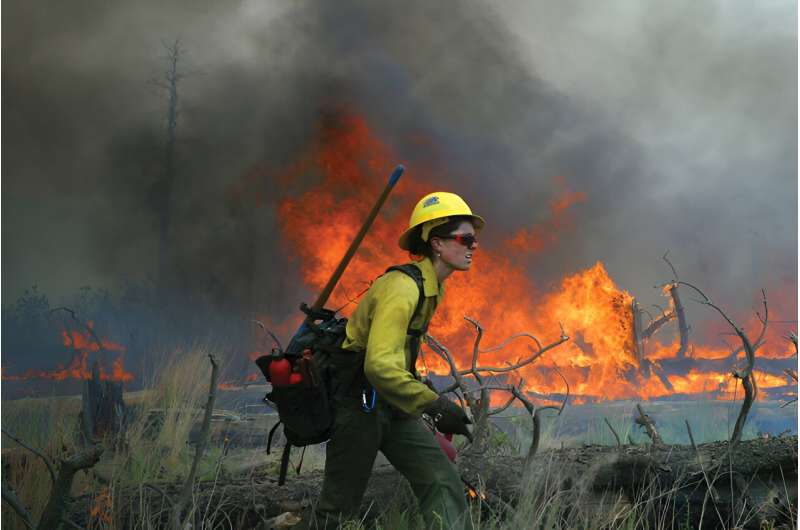
Severe wildfires increase with a decrease in prescribed burns—but new research shows that in some places across the United States there may be fewer opportunities to safely burn in the future.
“Prescribed fires are an important management tool for fuel loads, fire risk, and ecosystem health,” said Los Alamos Earth and Environmental Sciences Division Scientist Alex Jonko, the corresponding author of a new paper in npj Climate and Atmospheric Science about climate projections that are expected to affect the number of available windows to conduct prescribed burns.
“If we have fewer prescribed burns we could expect fuel loads to accumulate, leading to higher risk of catastrophic wildfires with more severe impacts on communities and ecosystems.”
Prescribed fire clears away excess organic material so that unexpected fires are less likely to get out of control. Prescribed burning is getting harder as temperatures rise and fuel loads are larger and drier. These fuel reserves need to be burned safely to limit risk.
Winds of change
Jonko’s team analyzed the effects that daily temperature, relative humidity and wind speed have on prescribed burns and evaluated the number of days in the future when prescribed burns will be advisable.
They used 2006–15 as a baseline to build their analysis, based on fire prescription data for 83 locations throughout the continental U.S. The team used this prescription data in conjunction with climate model projections for two future climate scenarios to show how availability of burn days might change in the future.
The results show the projected changes for each area during the 2051–60 period. While increased maximum temperatures lead to a reduction in potential prescriptions, increasing minimum temperatures and decreasing wind speeds can heighten opportunities to burn.
What happens if we burn less?
In some ways, the United States has already conducted this experiment. For more than 100 years, the U.S. took a position of fire suppression rather than working with fire’s role in ecosystems. This led to a massive buildup of fuel that has helped contribute to today’s large and unpredictable wildfires. Despite more challenging conditions, the country will need to continue to find time to conduct prescribed burns.
“There is a margin of error built into the prescriptions that could potentially be reduced with increased understanding of fire behavior. This is what the fire modeling team at Los Alamos National Lab works on,” Jonko said.
Even as it becomes more difficult to find windows for prescribed burns, it is important to maintain or increase the number of controlled burns across the U.S. Large swaths of the country are conducting fewer prescribed burns than needed to prevent the unnaturally destructive wildfires, especially in the West. In order to promote heathy fire policy, it may need to evolve to incorporate unconventional strategies.
“Right now, crews rarely if ever conduct prescribed burns at night, when conditions are generally more favorable. There are challenges associated with that, but in areas where climate change is going to drastically reduce the window for burning, that might need to be explored more seriously as an option,” Jonko said.
More information:
Alex Jonko et al, How will future climate change impact prescribed fire across the contiguous United States?, npj Climate and Atmospheric Science (2024). DOI: 10.1038/s41612-024-00649-7
Provided by
Los Alamos National Laboratory
Citation:
Climate projections show fewer opportunities for prescribed fires (2024, July 1)
retrieved 1 July 2024
from https://phys.org/news/2024-07-climate-opportunities.html
This document is subject to copyright. Apart from any fair dealing for the purpose of private study or research, no
part may be reproduced without the written permission. The content is provided for information purposes only.




